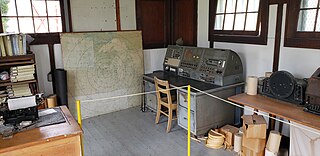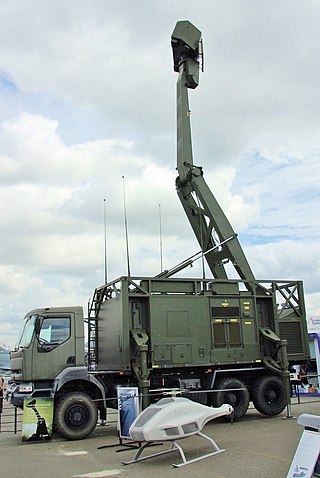Related Research Articles

Saab AB is a Swedish aerospace and defence company, founded in 1937. Headquartered in Stockholm, the development and the manufacturing is undertaken in Linköping. Saab produced automobiles from 1947 until 1990 when the automobile division was spun off as Saab Automobile, a joint venture with General Motors. The joint venture ended in 2000 when GM took complete ownership. From 1968 onwards the company was in a merger with commercial vehicle manufacturer Scania-Vabis, known as Saab-Scania. The two were de-merged in 1995 by the new owners, Investor AB. Despite the demerger, both Saab and Scania share the right to use the griffin logo, which originates from the coat of arms of the Swedish region of Scania.

Air traffic control (ATC) is a service provided by ground-based air traffic controllers who direct aircraft on the ground and through a given section of controlled airspace, and can provide advisory services to aircraft in non-controlled airspace. The primary purpose of ATC worldwide is to prevent collisions, organize and expedite the flow of air traffic, and provide information and other support for pilots.

The Saab JAS 39 Gripen is a light single-engine multirole fighter aircraft manufactured by the Swedish aerospace and defense company Saab AB. The Gripen has a delta wing and canard configuration with relaxed stability design and fly-by-wire flight controls. Later aircraft are fully NATO interoperable. As of 2020, more than 271 Gripens of all models, A–F, have been delivered.

Stockholm Arlanda Airport is an international airport located in the Sigtuna Municipality of Sweden, near the town of Märsta, 37 kilometres (23 mi) north of Stockholm and nearly 40 kilometres (25 mi) south-east of Uppsala. The airport is located within Stockholm County and the province of Uppland. It is the largest airport in Sweden and the third-largest airport in the Nordic countries. The airport is the major gateway to international air travel for large parts of Sweden. Arlanda Airport was used by nearly 27 million passengers in 2017, with 21.2 million international passengers and 5.5 million domestic.

A flight service station (FSS) is an air traffic facility that provides information and services to aircraft pilots before, during, and after flights, but unlike air traffic control (ATC), is not responsible for giving instructions or clearances or providing separation. They do, however, relay clearances from ATC for departure or approaches. The people who communicate with pilots from an FSS are referred to as flight service specialists.
Rannoch Corporation, was an American company based in Alexandria, Virginia. It was a research, development and production company working in the field of radar tracking for airport management, ground and airspace control and air defence.

The Austrian Air Force is a component part of the Austrian Armed Forces.

An airport surveillance radar (ASR) is a radar system used at airports to detect and display the presence and position of aircraft in the terminal area, the airspace around airports. It is the main air traffic control system for the airspace around airports. At large airports it typically controls traffic within a radius of 60 miles (96 km) of the airport below an elevation of 25,000 feet. The sophisticated systems at large airports consist of two different radar systems, the primary and secondary surveillance radar. The primary radar typically consists of a large rotating parabolic antenna dish that sweeps a vertical fan-shaped beam of microwaves around the airspace surrounding the airport. It detects the position and range of aircraft by microwaves reflected back to the antenna from the aircraft's surface. The secondary surveillance radar consists of a second rotating antenna, often mounted on the primary antenna, which interrogates the transponders of aircraft, which transmits a radio signal back containing the aircraft's identification, barometric altitude, and an emergency status code, which is displayed on the radar screen next to the return from the primary radar.
Leesburg Executive Airport at Godfrey Field is a town-owned public-use airport located three nautical miles south of the central business district of Leesburg, a town in Loudoun County, Virginia, United States.

The Saab Giraffe Radar is a family of land and naval two- or three-dimensional G/H-band passive electronically scanned array radar-based surveillance and air defense command and control systems tailored for operations with medium- and Short Range Air Defense (SHORAD) missile or gun systems or for use as gap-fillers in a larger air defense system. The radar gets its name from the distinctive folding mast which when deployed allows the radar to see over nearby terrain features such as trees, extending its effective range against low-level air targets. The first systems were produced in 1977. By 2007, some 450 units of all types are reported as having been delivered.

Northeast Florida Regional Airport, is located approximately four miles (6 km) north of historic St. Augustine, in St. Johns County, Florida, United States. NFRA serves as a key connection point for air travel in the Northeast Florida region. It is a public airport managed by the St. Johns County Airport Authority on behalf of the citizens of St. Johns County. Airport facilities include both commercial and general aviation terminals. On October 12, 2021, Elite Airways announced new non-stop jet service from St. Augustine (UST) to Newark, NJ (EWR) /New York City, beginning on November 19, 2021.
The Next Generation Air Transportation System (NextGen) is an ongoing United States Federal Aviation Administration (FAA) project to modernize the National Airspace System (NAS). The FAA began work on NextGen improvements in 2007 and plans to finish the final implementation segment by 2030. The goals of the modernization include using new technologies and procedures to increase the safety, efficiency, capacity, access, flexibility, predictability, and resilience of the NAS while reducing the environmental impact of aviation.
AirNav Systems is a Tampa-based global flight tracking and data services company founded in 2001. The company operates a flight tracking website and mobile app called Radarbox which offers worldwide tracking of commercial and general aviation flights. AirNav Systems also owns and operates a ground-based ADS-B tracking network that is supported by over 20,000 active volunteer ADS-B data feeders from over 180 countries. The company's real-time tracking and data services are also used by 25,000 aviation related businesses, government agencies, airlines, media channels and airports in over 60 countries.

The Air Traffic Organization (ATO) is an air navigation service provider in the United States of America. The ATO is the operational division of the Federal Aviation Administration (FAA).
Swedavia AB is a Swedish state-owned company, which owns and operates ten of Sweden's busiest airports. It has its head office at the air traffic control tower of Stockholm-Arlanda Airport in Sigtuna Municipality near Stockholm.
Remote and virtual tower (RVT) is a modern concept where the air traffic service (ATS) at an airport is performed somewhere other than in the local control tower. Although it was initially developed for airports with low traffic levels, in 2021 it was implemented at a major international airport, London City Airport.
Exelis Inc., was a global aerospace, defense, information and services company created in October 2011 as a result of the spinoff of ITT Corporation's defense business into an independent, publicly traded company. The company was headquartered in Tysons Corner, Virginia, USA and was led by CEO and President David F. Melcher. The Washington Post highlighted Exelis as a top company in the Washington, D.C. region in 2011. It was acquired by the Harris Corporation for $4.75 billion in 2015.

The AN/TPS-80 Ground/Air Task Oriented Radar (G/ATOR) is the United States Marine Corps next-generation Air Surveillance/Air Defense and Air Traffic Control (ATC) Radar. The mobile active electronically scanned array radar system is currently being developed by Northrop Grumman and was expected to reach initial operating capability in August 2016.
Airport surveillance and broadcast systems are a set of runway-safety tools that display aircraft on and near an airport.

Airway Transportation Systems Specialists', also known as (ATSSs; FV-2101) are Systems Electronics Technicians assigned to the Technical Operations (TechOps) section of the Federal Aviation Administration's Air Traffic Organization (ATO). Airway Transportation Systems Specialists possess theoretical and practical knowledge in electronic theory and characteristics, functions, operations, and capabilities of a variety of National Airspace System (NAS) systems. Airway Transportation Systems Specialists ensure the safety and efficiency of the NAS by performing preventive maintenance, corrective maintenance, and system modifications of air traffic control systems at ATCTs, TRACONs, and ARTCCs throughout the United States of America. ATSS generally possess years of theoretical and practical knowledge in electronic theory and characteristics, functions, operations, and capabilities of a variety of U.S. National Airspace System (NAS) systems. Airway Transportation Systems Specialists are responsible for the maintenance, operation, fabrication, installation, and management of the technical infrastructure of the National Airspace System. Airway Transportation Systems Specialists work at different Systems Support Centers (SSCs) in the United States. Airway Transportation Systems Specialists install, maintain, repair, operate, and monitor hardware and software to ensure they work as designed. ATSS certifies equipment and services to ensure safe and efficient flight operations throughout NAS. The FAA workforce currently includes 5,200 ATSS nationwide.
References
- ↑ "Saab to Acquire Sensis Corporation". Saab AB. 2011.
- ↑ "Saab Consolidates U.S. Defense Businesses". National Defense Industrial Association. 2013.
- ↑ "Saab Sensis Commissions 35th ASDE-X System". Saab AB. 2011.
- ↑ "Sweden's LFV Inaugurates First 'Remote Tower' Operations". AIN Transport. 2015.